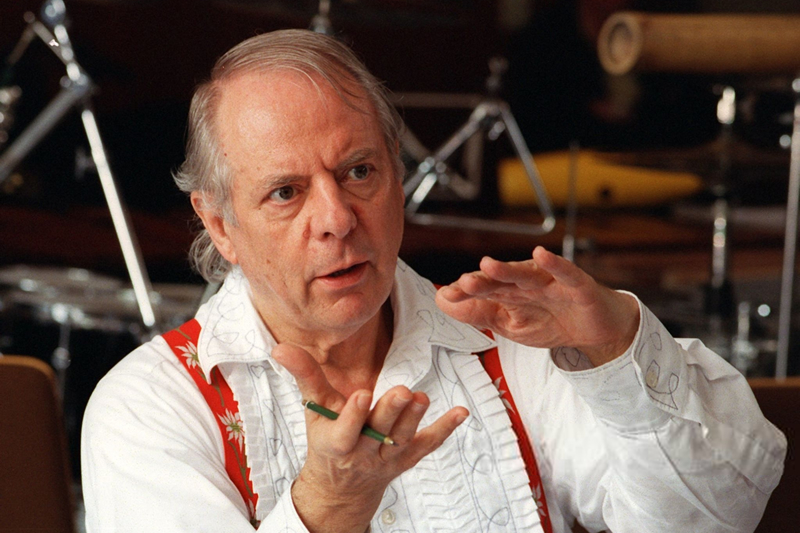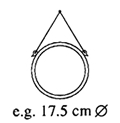
Instrumentation Works for Orchestra
Stockhausen Complete Edition on CD
Since 1991, a complete edition of all recordings in which Karlheinz Stockhausen has personally participated is being released on compact discs. Each CD in this series is identified by Stockhausen's signature followed by an encircled number. The numbers indicate the general historical order of the works.
Stockhausen realised the electronic music and participated in these recordings as conductor, performer, sound projectionist, and musical director. He personally mixed down the recordings, mastered them for CDs, wrote the texts and drew the covers.
- The compact discs may be obtained from the Stockhausen-Verlag: Kettenberg 15, 51515 Kuerten, Germany (www.stockhausenCDs.com).
Karlheinz Stockhausen
Instrumentation Works for Orchestra
DER JAHRESLAUF (THE COURSE OF THE YEARS)
Instruments of the orchestra
JAHRESLAUF was composed – as has been said – in 1977 for Gagaku orchestra, and was world premiered by the musicians of the Imperial Gagaku Orchestra.
The first concert performance and recording with European instruments took place at the WDR in Cologne in 1979. In all performances since then, European instruments have been used.
In the following list of instruments, the European instrument is named first, followed by the Japanese Gagaku instrument. If the European instrument(s) can be replaced by modern electric instrument(s), these come in second place in parentheses.
(All instruments are amplified: see sound equipment.)
| 3 | harmoniums (or synthesizers / samplers) or sho (see explanation 1) |
|
| 1 | anvil or shoko, for example  see explanation 2) |
|
| 3 | piccolo flutes or ryuteki  (see explanation 3) |
|
| 1 | bongo or kakko  (see explanation 4) |
|
| 3 | soprano saxophones or hichiriki (see explanation 5 ) | |
| 1 | bass drum or taiko etc. etc.(See explanation 6) |
( Glissandi and different pitches result automatically.) |
| 1 | (elec.) harpsichord (or synthesizer / sampler) or gakuso  (see explanation 7) |
|
| 1 | (elec.) guitar (with plectrum) or biwa (see explanation 8) |
Portable instruments for the final procession
3 accordions or melodicas (wind instruments with keyboard) for the harmonium
(synthesizer / sampler) players;
2 antique cymbals (hit against each other) or metal tube or shoko;
1 bongo or kakko (held in one hand or hung over the shoulder);
1 bass drum (held by one hand or hung over the shoulders).
Explanations about the instruments
1) Harmoniums (or synthesizers / samplers) or sho
For the three sho, the 15 pitches of the traditional scale were used
individually:

and only the following 11 chords, which are also indicated in the
score by their traditional numbers to facilitate identification (there
are 7 and 7' , but no 10):

In the score, the sho pitches are notated as sounding. The Gagaku
players requested, however, that in the parts all pitches be notated
an octave lower to avoid the many ledger-lines. They also requested
the omission of the chord-numeration.
Harmonium (synthesizer / sampler) players must therefore play
their parts an octave higher.
The range of most harmoniums ends at .
.
It is therefore necessary to specifically order harmoniums whose
ranges extend to 
They should in addition have at least three 4' registers and approximately two 2' registers as well as vox coelestis, vox humana, aeolean harp (all with vibrato) and several others for timbre changes and dynamic differentiation. Each player then implements his own dynamic scale  -
-  -
-  -
-  -
-  -
-  by switching on additional registers.
by switching on additional registers.
For accents and crescendi or decrescendi the right-knee sweller should be used (not the left swell because this adds the lower octave). No register having a 16' effect (addition of the lower octave) should be used.
Since good harmoniums are very difficult to find, the timbres of the 3 harmoniums can either be programmed and played using synthesizers, or harmonium or sho timbres can be recorded and
played on samplers.
2) Anvil or shoko
The shoko used in the world première had the three pitches indicated, depending on how it was struck with a metal beater. Its sound had a rapid decay. A European instrument having a similar sound in this register is an anvil, beaten with a heavy blacksmith's hammer.
It is also possible to use a cast-iron or steel tube which has a similar sound. For single beats, metal beaters are used, and for trills, lighter hard plastic beaters.
It is also possible to use a geisha bell : hung with its polished side away from the player, it is played on its inside rim or at its centre with 2 horn beaters or hard plastic beaters.

The pitches of the geisha bell used by the composer:

3) Piccolo flutes or ryuteki
The flutists should — if possible — play wooden piccolos or ryuteki.
For the low C-sharp, piccolo players must turn the flute inwards.
Another possibility — but less dependable — is to cover the end of the tube 2/3 with the little finger and pull down the pitch with the embouchure.
For the glissandi starting at bar 199, the piccolo players must practice slowly ascending and descending lip glissandi (possibly supported with fingering changes), as well as glissandi with accelerando or ritardando.
The piccolos or ryuteki sound an octave higher than notated.
4) Bongo or kakko
The pitch of a kakko drum is

It is played using 2 thin sticks.
A bongo should, when hit at the centre, have the same pitch or  .
When playing groups of beats, however, all pitch and timbre nuances between the centre and the edge should be
exploited.
.
When playing groups of beats, however, all pitch and timbre nuances between the centre and the edge should be
exploited.
5) Soprano saxophones or hichiriki
The sound of the hichiriki most resembles that of a soprano saxophone. It is recommended that the soprano saxophone players listen to a recording of JAHRESLAUF played by hichiriki and that they imitate that manner of playing (especially the glissandi) and the timbre. There are transposed parts in B-flat for soprano saxophones and untransposed parts for hichiriki.
6) Bass drum or taiko
The bass drum should sound similar to a taiko. It should be tuned
to  (when beaten at the centre of the head).
(when beaten at the centre of the head).
At hart (hard) it is beaten at the outer edge of the head so that it
sounds much higher (circa  ) with long decay.
) with long decay.
It is struck with 2 hard felt beaters:
weich (soft) at the centre of the head, > (accent) hart (hard)
which is also always louder, at the outer edge.
R = right hand, L = left hand.
7) (Elec.) harpsichord (or synthesizer/ sampler) or gakuso
Either the equipment for amplification (microphones etc.) is already built into the harpsichord, or additional microphones or 2 contact microphones for treble and bass (with volume, treble and
bass controls for the player) and monitor loudspeakers are used for amplification.
The overall amplification must be controlled from the mixing console at the centre of the hall. The built-in harpsichord amplifier with a second output as well as additional microphones are circuited to the mixing console and projected over several loudspeakers
(see sound equipment).
It is also possible to play a synthesizer or sampler having harpsichord or gakuso timbres. In this case, the monitor loudspeaker must be quite powerful, placed behind the player and pointed diagonally towards him and the other players. Two parallel circuits lead to the mixing console in the hall.
Gakuso players are not accustomed to notation on two staves, so
a gakuso player may have to arrange his part to facilitate reading.
8) (Elec.) guitar or biwa
Either an electric guitar or a classical guitar amplified with a microphone is used. The monitor loudspeaker stands next to the player. In either case, the sound is also controlled at the mixing console and projected over several loudspeakers. A classical guitar usually sounds better than a normal electric guitar. The guitar — like a biwa — should be played using a plectrum, and depending on the context, sul ponticello.
Like a biwa, it is possible to use only 4 strings, tuned 